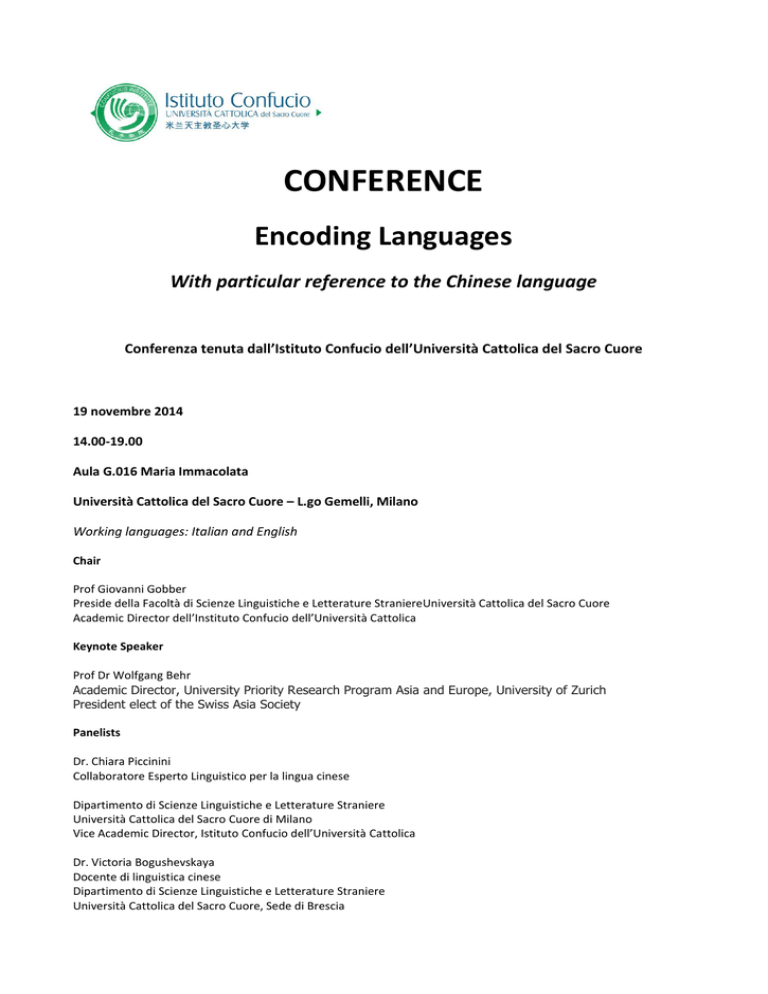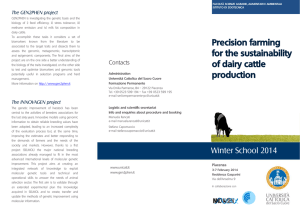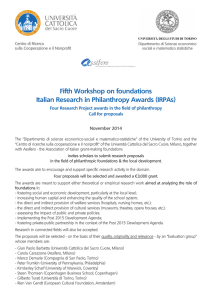CONFERENCE
advertisement

CONFERENCE Encoding Languages With particular reference to the Chinese language Conferenza tenuta dall’Istituto Confucio dell’Università Cattolica del Sacro Cuore 19 novembre 2014 14.00-19.00 Aula G.016 Maria Immacolata Università Cattolica del Sacro Cuore – L.go Gemelli, Milano Working languages: Italian and English Chair Prof Giovanni Gobber Preside della Facoltà di Scienze Linguistiche e Letterature StraniereUniversità Cattolica del Sacro Cuore Academic Director dell’Instituto Confucio dell’Università Cattolica Keynote Speaker Prof Dr Wolfgang Behr Academic Director, University Priority Research Program Asia and Europe, University of Zurich President elect of the Swiss Asia Society Panelists Dr. Chiara Piccinini Collaboratore Esperto Linguistico per la lingua cinese Dipartimento di Scienze Linguistiche e Letterature Straniere Università Cattolica del Sacro Cuore di Milano Vice Academic Director, Istituto Confucio dell’Università Cattolica Dr. Victoria Bogushevskaya Docente di linguistica cinese Dipartimento di Scienze Linguistiche e Letterature Straniere Università Cattolica del Sacro Cuore, Sede di Brescia Programme Prof Dr Wolfgang Behr Marginal Characters In the popular literature, the Chinese writing system is often portrayed as being forbiddingly complex and erratic, while the typical sinological narrative still prefers to analyse Character structures in terms of the six categories of writing (liù shū 六書) inherited from the Shuōwén 說文 tradition. If the popular account tends to look for complexity in all the wrong places, the Eastern Han liù shū theory and most of its later variants notoriously mixes up emic and etic, functional and structural layers. It thus fails to capture some of the less mainstream character construction principles, odd at first sight, but recurrent throughout the history of Chinese writing. The keynote talk will approach these fairly marginal character structures from the typological vantage point of a comparison with other complex logographic writing systems of the Ancient world and point to parallels and remnants of such structures in the areal Sino-Xenic logographies developed in close contact with Chinese models. It is hoped that a look from the margins will help to address the perennial questions of why mainstream Chinese writing failed to develop into syllabic or even subsyllabic writing, and how the notion of writing system oddity can be usefully complicated if acquisition, performance, functional and ludic perspectives are better separated. Dr. Chiara Piccinini Mnemonics as a key to learning Chinese characters Written Chinese language is made of single logical-semantic units that cannot be modified at a formal level. The single units of the written Chinese language can have different grammatical functions and a wide semantic value at the same time. This linguistic feature makes it difficult to Italian learners to learn Chinese characters, because of their difference with the written European languages. Learning how Chinese characters are structured and how they work in context is thus necessary in order to be able to use the Chinese language in a proper way. Although mnemonics is not always respectful of the etymological origin of characters, it can be useful to build ‘mental networks’ that help learners organize efficaciously the way they perceive Chinese language. Dr. Victoria Bogushevskaya How Written Chinese Characters are Processed in the Brain (evidence from phonosemantic compounds) There are two important traditions of writing systems – the alphabetic system (phoneme based script) and the Chinese logosyllabic system (non-phoneme based script). Alphabetic words have a linear structure and their recognition processes are lateralized to the left cerebral hemisphere. In contrast, Chinese characters have a nonlinear configuration and possess a number of strokes that are packed into a square shape. Thus, the character as a whole is a salient perceptual unit, a “mental image” that presents pictorial characteristics. However, characters of the most numerous—phonosemantic (形声 xíngshēng)—category possess a phonological component in their structure, that has a functionality similar to the graphemephoneme mapping of English words. In contrast to the alphabetic writing system, the single Chinese character presents semantic and phonetic information simultaneously, albeit neither very precisely. Characters can have regular, semi-regular or irregular pronunciation, or can belong to a specific type, where its phonological component has more than one pronunciation. Although semantic constituents were created to represent specific semantic categories in phonosemantic-type characters, these semantic representations are not always consistent. Learning process of various strokes, memorizing the right location and proportions of subunits for each character, repeatedly copying and pronouncing samples of characters so as to establish the linkage between orthographic, phonological, and semantic content of characters is strongly associated with one’s ability to read Chinese and should be constantly (self-) encouraged.













